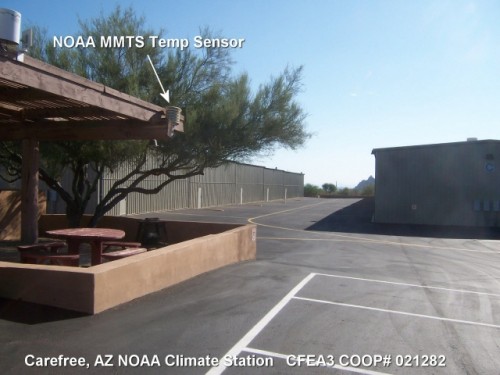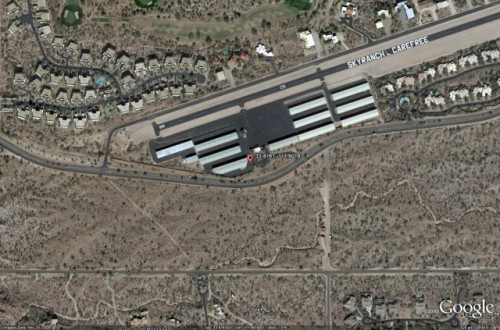Steve Goddard and Anthony Watt have a series of posts on an old favorite topic on this site — how data manipulations back in the climate office is creating a lot of the “measured” warming. This particular example is right here in Arizona, and features several sites my son and I surveyed for Anthony’s site. They have a followup on another Arizona station here. Check out all the asphalt:

This is a hilariously bad siting. It demonstrates how small things can sometimes have big effects. The MMTS sensor has a very limited cable length. This does not mean that it only comes with a short cable (begging the question of why they can’t just buy a longer one), but that it can only have a short cable due to signal amplification issues. As a result, we get this terrible siting because it needs to be close to the building, whereas even a hundred yards away there were much better locations

Carefree is a fairly rural (at least suburban) low density town with lots of undeveloped land. They had to work to get a siting this bad. A monkey throwing darts at a map of the area would have gotten a better siting.

Hello Warren, thank you for the notice.
But please, a reminder for the kajillionth time WATTS with an S
Also, Steve Goddard does posts on sea ice, not stations.
Thank you for your consideration.
Anthony Watts
The climate alarmists like to claim that the only thing that matters is the difference in temperature until a record is set. Then the absolute temperature suddenly gets to be important.
They also claim that siting doesn’t matter because somehow asphalt and concrete warm just as much due to a change in radiation etc as does grass and soil. Sounds unlikely to me.
What seems to happen is that they adjust the good sites to be just as bad as the bad sites so there is little difference between them.
Here are NOAA’s own admission of adjustments made to raw temperatures.
Notice the 5 ° F added to the most recent temperatures.
Equipment changes should all balance out but UHI adjustments should all be DOWN and more down in later years so the curve is upside down.
http://cdiac.ornl.gov/epubs/ndp/ushcn/ts.ushcn_anom25_diffs_urb-raw_pg.gif
I have observed before that while DFW was converted from a cow pasture in 1977 to an international airport today there has been virtually no adjustment downward to account for UHI except to lower some of the older readings to enhance the apparent warming. Current Raw and Adjusted readings are identical. Poor UHI adjustment isn’t it ?
.
RAW 2007 19.73, 2008 20.43, 2009 19.82 Homogenized 19.73, 2008 20.43, 2009 19.82. Difference zip !
.
How much warming can a runway cause anyway ?
.
On hot summer days, the firefighting crews at Albany International Airport use sensors to find out just how hot the runways and aprons become. That, airport spokesman Doug Myers tells us, is to let the emergency workers calculate what the “flash point” of spilled fuel would be.
.
Perhaps it’s no surprise that the airport surfaces absorbed a lot of heat today. When firefighter Robert Scanlon measured it, the tarmac registered 192 degrees Fahrenheit, just 20 degrees short of the boiling point of water..
.
On previous hot summer days, airlines often had to “bump” a few passengers and some cargo so that they could get airborne. Hot air has less lift than cold air, so a fully loaded passenger plane, especially one with a long flight ahead, would take more runway to get into the air on hot days. Now that the airport runways have been lengthened, however, that’s no longer a problem. Myers said he wasn’t aware of any flights having to lighten their load.
http://blog.timesunion.com/business/tarmac-at-albany-international-airport-hits-192-degrees/20562/
I find it interesting that in attempt to defend against challenges to the accuracy of surface temperature AGW advocates fixate of UHI, when that’s only one part of the larger issue of changed land use patterns in general. Watts makes a convincing case that the surface temperature record is significantly biased in ways convenient to hypotheses espoused with partisan fervor by some of the very same groups making those measurements. This is damning on several counts, not least being observer bias by those seeing (or measuring) what they WANT to see. Their attachment to the utility of the argued errors makes them almost entirely deaf to all criticism, however valid.
“This does not mean that it only comes with a short cable (begging the question of why they can’t just buy a longer one), but that it can only have a short cable due to signal amplification issues. As a result, we get this terrible siting because it needs to be close to the building, whereas even a hundred yards away there were much better locations”
And now they beg the question of why they can’t buy a better cable. Seriously are there no cables that can be designed that don’t have these problems over 100m? We’ve been making cables for over a 100 years, surely we’ve licked these problems by now. Hell the don’t even have to solve the problem, just account for it.
Michael: It’s probably an issue of signal strength, not cable quality. You just can’t run a weak analog signal very far without losing accuracy.
I’ve designed data acquisition systems. It’s best to have a pre-amp right next to the sensor, and as short a run from the pre-amp to the analog to digital converter as possible. But these circuits generate heat… So I guess the designers chose not to amplify or digitize in the sensor box, instead buying a very expensive cable to run the unamplified analog signal as far as possible – which in many places isn’t far enough to get from the building to a good location.
But why does that short cable have to run to a building? For probably less than they spent on a cable, you could amplify and digitize the signal in a second box a few feet away, and send the numbers out on ethernet or RS-485. With either one of those digital connections, the basic circuit is over 100 feet, and there are repeaters, extenders, and modems that can send it an unlimited distance. If you insist on putting the recording computer in your office in the middle of miles of pavement, the sensors could be in a forest 10 miles away; all that’s needed is a phone line or wireless connection. Or budget for an internet connection and read the temperature in Sri Lanka from Houston.
My suspicion is that some boneheaded bureaucrat (or climate scientist without a clue about electrical engineering) restricted the engineers to one outdoors box. I’ve encountered such arbitrary restrictions in work for corporations, but government projects are much worse.